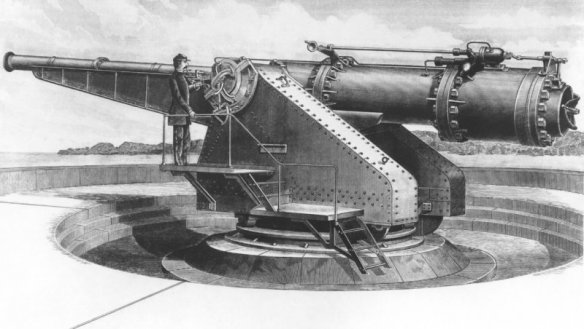Zalinski Dynamite Torpedo Cannon.
One type of gun was to use compressed air as the propulsive medium. This actually reached service in the US in the 1890s with the adoption of the Zalinski Dynamite Torpedo Cannon as a coast-defence gun and as a naval weapon. The weapon took its name from the fact that Zalinski, the promoter, envisaged firing heavy dynamite-filled contact mines (then known as torpedoes) in the coast-defence role. Three Zalinski guns were installed in the USS Vesuvius in 1890. Of 15- in (381-mm) caliber, they threw a 454-kg (1000-1b) fin-stabilized shell, but the maxi- mum range was not comparable with conventional guns. Five 15-in coast-defence guns were built and installed but, once again, the rapid improvements in conventional ordnance in the 1890s soon made the dynamite gun obsolete. One great drawback was that each gun demanded a building about 30 m (100 ft) long to house the steam engines and compressors.
The object behind all this equipment was simply to devise a method of launching a shell carrying a heavy payload of highly sensitive explosive-dynamite-at a time when the difficulty of devising a suitable HE shell for conventional guns seemed insuperable. But with the arrival of Lyddite, Amatol and TNT, all explosives capable of sustaining fierce acceleration, the need for such weapons died away. Not before it had been tried out in a field gun, though; during the Spanish-American War some 15 Sims-Dudley Pneumatic Field Cannon were taken into use by the US Army. These used an explosive cartridge fired into an expansion chamber beneath the barrel to generate high-pressure gas which was then leaked into the gun barrel to deliver gentle acceleration to the shell. According to the official history the guns were deployed at the battle of San Juan Hill but did not fire because nobody could find the ammunition. A few must have remained in the manufacturer’s hands since they were offered to the British Army in 1915, though without being accepted.
No discussion of carriage mounted weapons firing mortar bombs would be complete with mentioning the Wartime German PAW 600, also known as the PWK 8H63. This used a round that was comprised of an 81mm mortar bomb, a casing from the LeFH-18 105mm Howitzer and a perforated steel plate with a spigot. The mortar bomb was fitted to the spigot with a shear pin and the propellant charge was 360gm diglycol. The PAW 600 was one of the first weapons to use the High-Low pressure system now familiar from 40mm Grenade Launchers. This allowed a powerful charge to be used with a light barrel. The entire weapon weighed only 600kg but had a muzzle velocity of 520m/s (1706 fps). This compares very favourably with the 1260 fps muzzle velocity of the L24 75mm gun used for vehicle mounted close support weapon. In the anti-tank role the PAW 600’s HEAT round could penetrate 140mm of armour at 750m, while for indirect fire range is given as 6000m. The same bomb fired from the GrW34 mortar only reached 2400m.
Specifications:
8-cm PAW(Panzerabwehrwerfer) 600 aka PWK (Panzerwurfkanone) 8H 63
Weight: 610 kg
Barrel length: 2980 mm
Muzzle velocity: 520 mps
Armour penetration: 145 mm
Wgr.Patr 4462 round length: 620 mm
The round weight: 7 kg
HEAT projectile weight: 2.75 kg
In January 1945 81 pieces of the PAW600 were delivered to front units. By the end of the war the weapons were issued to the 30th and 31st Panzer-Grenadier-Regiments. Both regiments had 105 such guns.
A close relative of the Sims-Dudley was the German High-and-Low Pressure Gun developed in 1943-44 by Rheinmetall-Borsig. This was a light smoothbore weapon, intended for infantry antitank use which fired a finned hollow charge bomb to a range of about 800 m (880 yards) with quite respect- able accuracy. Propulsion was by a 10.5-cm (4.1-in) howitzer cartridge fitted with a heavy steel closing plate pierced with four venturi holes. This confined the high-pressure side of the cartridge explosion to the gun chamber, which was suitably reinforced, and bled the gases into the gun barrel at low pressure to propel the bomb, so that a lightweight barrel could be used. Although successful, the idea was not pursued after the war by the major powers, and only the Swiss developed a similar weapon for use in an armoured car. More recently however, a gun on similar lines has appeared on the Soviet BMP-1 MICV.
